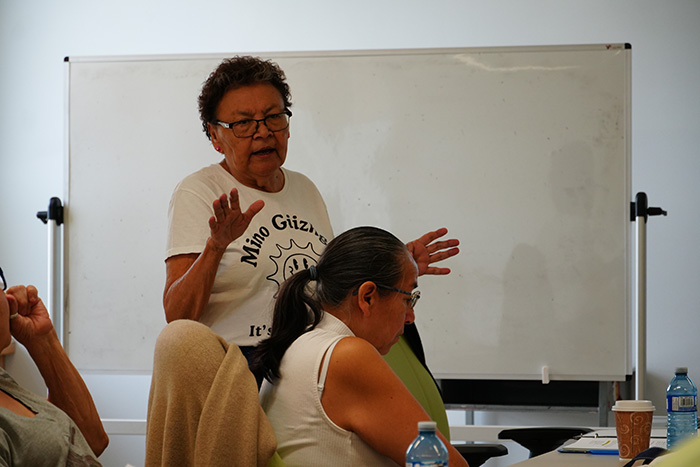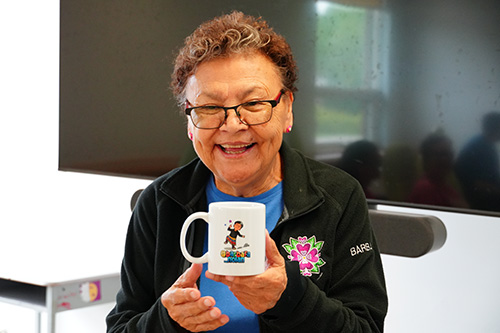
On May 29 & 30, the Lifelong Learning Centre, hosted the highly acclaimed and special guest, Barbara Nolan; Language Commissioner for the Anishinabek Nation. An ‘Ojibwe Elder and Nishnaabemwin-language immersion teacher’ from Garden River, having grown up in Wiikwemkoong (and where her heart remains), has a long history of teaching and developing resources to help encourage new and long-time language speakers. One particular App available to iOS and Android users, is ‘Nishnaabemdaa’. Her website can be found at www.barbaranolan.com.
Barbara’s focus on immersion learning incorporates the concept of language exposure to young children and adults amidst everyday ‘on the land’ learning and experiences, for example picking blueberries or cleaning fish, to general daily routines such as starting the fire or cooking a meal. Offering the Anishinaabe word in place of the English word for everyday objects and places, is a great way to develop awareness of the language and culture, an openness and comfortable space to share the language between children, adults and Elders, and creates a solid foundation at an early stage for which to build Anishinaabe language and customs upon. “The best thing we can do (to revitalize the language) is having immersion starting in Daycare. The children can hear you, understand you, get used to your voice (how you pronounce words/become familiar with hearing the language)/become familiar with hearing the language)”, says Barbara. “The children don’t talk right away, so if they hear it (the language)from babies, by the time they’re 3-3.5 years old, they will know the language intuitively. Keep sharing it, not translating what you say, just speaking it.” Barbara, clearly devoted and passionate about the preservation of Anishinaabemowin stated “If I had known to stay speaking the language with my kids, they would be bilingual today. We were told not to speak the language, not to be proud of us as Anishinaabe people, but we need to throw that thinking away and be proud of who we are and our language and speak or teach it more openly.”
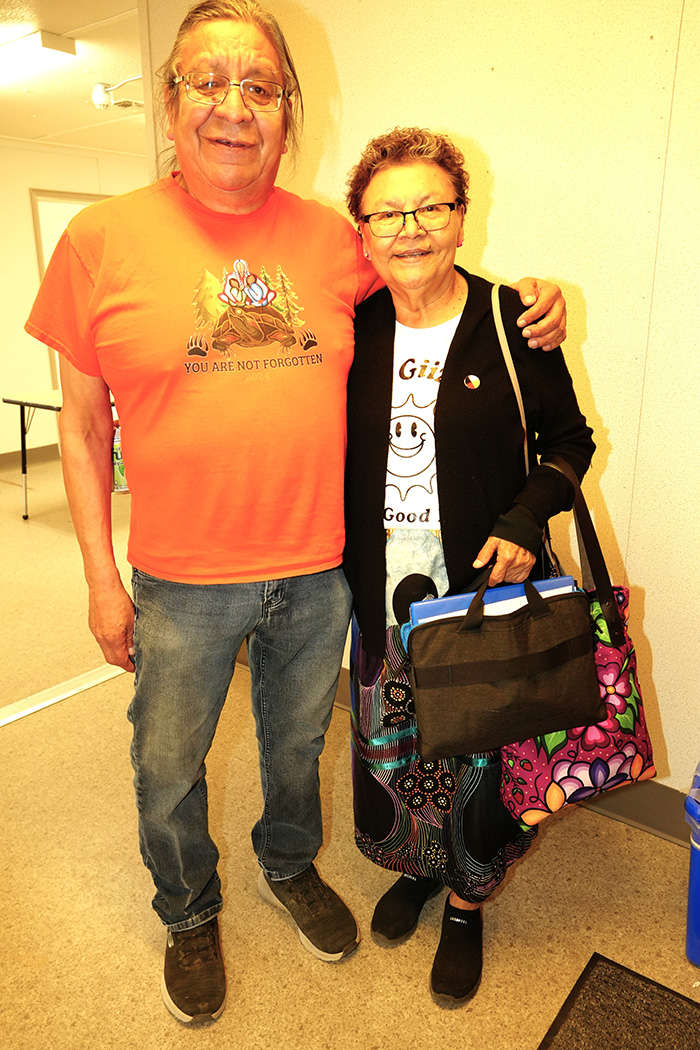
The workshop was attended by a variety of people – daycare or school educators, administrators, committee and council members, non-fluent and fluent speakers, those aged 20 up to 60+ years -- some present to learn how to teach the language in the school or home, some learning for personal development, others wanting to ensure the language continued and were looking to offer their knowledge to the community in some way and were discovering how that could look. Everyone present was invited to share why they were there and what they hoped to achieve from the workshop, which helped to solidify just how passionate and committed community members and departmental staff (indigenous and non-) are about resurrecting beloved Anishinaabe language and cultural traditions, and sustaining them.
Barbara responded to this hunger for language revitalization by providing training on how to:
· Gain knowledge of language acquisition, immersion, revitalization and bilingualism
· How to develop a strong foundation of the language
· How Anishinaabemowin is passed on to next generations
· Development of programming to facilitate the instruction ofproficient second language speakers of Anishinaabemowin
· Knowledge sharing on how to put your knowledge, talents and abilities to use in an immersion setting and delivery of this knowledge within the school, community and at home.
Barbara shared snippets of her personal journey towards the revitalization efforts of Anishinaabemowin over a career which spans her lifetime. There has been a lot of success and evolvement accomplished to date, and the necessity of present and future generations to embrace and with great relevance continue the work of the movement. The revitalization of the language and customs of Anishinaabe has seen impressive advancements and momentum over the past number of years, and she encourages everyone to continue supporting each other towards these efforts and along the path. It has not been easy work, but it is meaningful and necessary work.
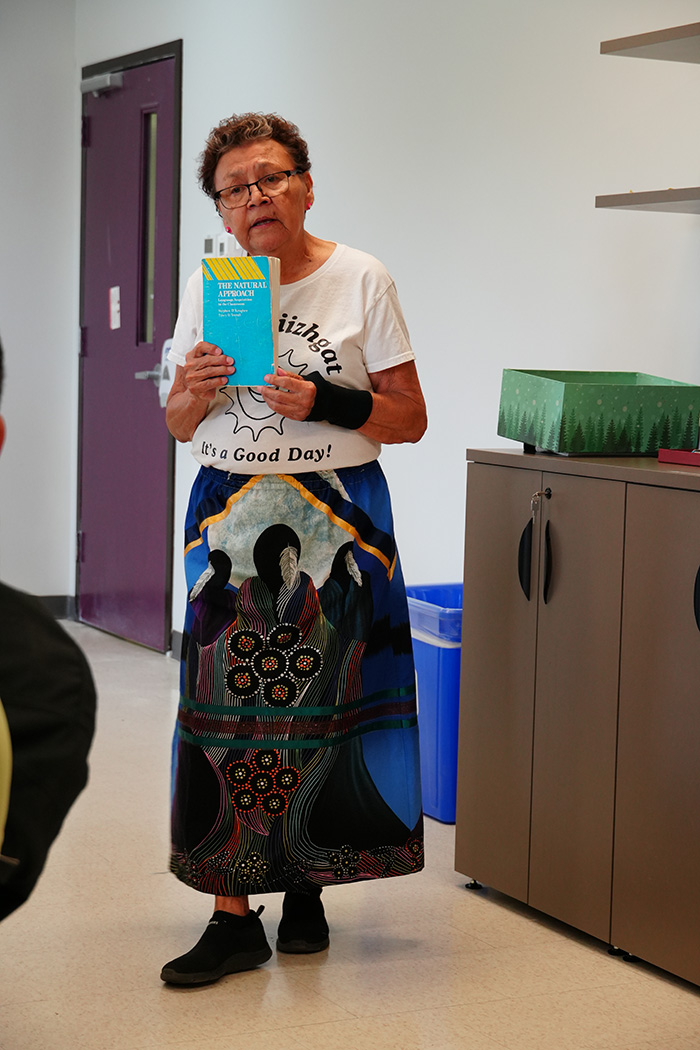
Her experiences have taught her that the adult students she teaches, who are learning the language for the first time, are like babies in her approach – they are just starting to learn. As an adult learner, she reminds attendees, we need to remember that it takes a long time to build a language. It is not just a few weeks or months of learning. However, daily and consistent practice and use of the language, listening to it spoken ,interacting with Elders and children in everyday conversation -- will cause it to become more familiar, more natural, and more engrained in us. A ‘Good Model’ of language revitalization involves: Language Revival, replacing Language Loss with Language Shift, and creating a Language Plan. She encouraged everyone to become a language apprentice – offer to share the knowledge you have, speak the language freely no matter what people say or think about how differently you pronounce or describe something versus the next person, don’t worry about making mistakes, be proud to speak your language not afraid or reluctant, and know that there will be similarities within the language dialects that will allow communities to understand what you are saying and all of this will continue the forward movement of language revitalization.
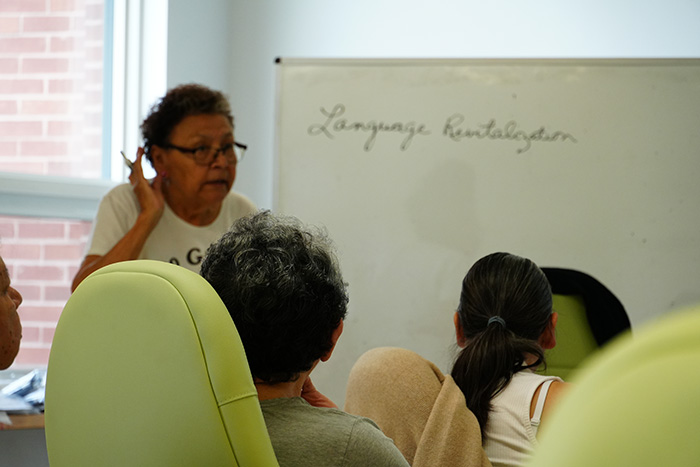
“We want to create speakers -- create little Anishinaabe, teaching them who we are, our gentleness, instill in them our traditions, our story, help them understand we can be proud of who we are”, was a constant message shared by Barbara over the two-day workshop. The group of attendees came away with a stronger understanding of what role they needed to play within language revitalization efforts, and how they could uniquely offer their current level of skills, knowledge, and passion towards this. Everyone has something to offer, and everyone was encouraged to take steps towards this common goal. The resurrection of a people, a way of life, and a story that explains it using Anishinaabe words.
Miigwech to Barbara Nolan for sharing her knowledge with Sagamok Anishnawbek and for visiting our community to provide inspiration and information on how to revitalize our language and our story and our love for both.
